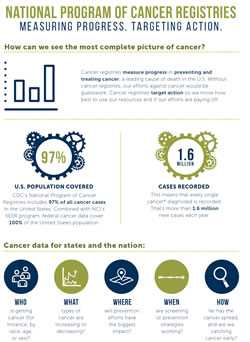About the Program
Established by Congress through the Cancer Registries Amendment Act in 1992, and administered by CDC, the National Program of Cancer Registries (NPCR) collects data on cancer occurrence (including the type, extent, and location of the cancer), the type of initial treatment, and outcomes.
Before NPCR was established, 10 states had no registry, and most states with registries lacked the resources and legislative support they needed to gather complete data. Today, through NPCR, CDC supports central cancer registries in 46 states, the District of Columbia, Puerto Rico, the U.S. Pacific Island Jurisdictions, and the U.S. Virgin Islands. These data represent 97% of the U.S. population.
Together, CDC’s NPCR and the National Cancer Institute’s (NCI’s) Surveillance, Epidemiology, and End Results (SEER) Program collect data for the entire U.S. population. This national coverage enables researchers, clinicians, policy makers, public health professionals, and members of the public to monitor the burden of cancer, evaluate the successes of programs, and identify additional needs for cancer prevention and control efforts at national, state, and local levels.
Cancer Registries: Providing High-Quality Cancer Data
Public health professionals, researchers, the medical community, and policy makers need information about newly diagnosed cancer cases (called incidence) and deaths from cancer (called mortality) to understand and address the nation’s cancer burden. Supported by CDC’s NPCR or the NCI’s SEER Program, central cancer registries collect incidence data. CDC’s National Center for Health Statistics’ National Vital Statistics System collects mortality data.
Medical facilities such as hospitals, doctor’s offices, and pathology laboratories send information about cancer cases to their cancer registry. Most information comes from hospitals, where highly trained cancer registrars transfer the information from the patient’s medical record to the registry’s computer software using standardized codes. The data are then sent to the central cancer registry.
Every year the central cancer registries electronically submit demographic and clinical information about cancer incidence to NPCR or SEER. None of the information submitted to CDC contains identifying information about individual patients.
The cancer registry data are used to—
- Monitor cancer trends over time.
- Show cancer patterns in various populations and identify high-risk groups.
- Guide planning and evaluation of cancer control programs.
- Help set priorities for allocating health resources.
- Advance clinical, epidemiologic, and health services research.
Software for Collecting and Processing Data
Since 1996, CDC has developed software programs to make the process of collecting and processing data more efficient and accurate for medical facilities and registries. CDC offers these software programs, which are compliant with national standards, free of charge to the public health community.
Data Release Activities
The more accessible, discoverable, and usable data are, the more impact they can have. One of NPCR’s goals is to release cancer data to public health planners and others to monitor the burden of disease and to implement cancer prevention and control programs. Each year, a number of online products are updated to include the most recent year of cancer data.
Addressing Cancer Burden and Risk Factors
CDC, often in collaboration with partners, uses the NPCR data to conduct epidemiologic studies on cancer burden and trends. Selected publications are listed below. You can search for other articles using NPCR data authored by researchers from CDC’s Division of Cancer Prevention and Control using the Cancer Research Citation Search Tool.
Annual Report to the Nation
Since 1998, CDC has collaborated with the National Cancer Institute, the North American Association of Central Cancer Registries, and the American Cancer Society to publish the Annual Report to the Nation on the Status of Cancer. Each year highlights a special topic, such as—
- The increasing incidence of liver cancer.
- Incidence of breast cancer subtypes by race/ethnicity, poverty, and state.
- The prevalence of comorbidity and impact on survival among persons with lung, colorectal, breast, or prostate cancer.
- Burden and trends in HPV-associated cancers and HPV vaccination coverage levels.
- Cancers associated with excess weight and lack of sufficient physical activity.
Cancer Surveillance Research
To improve the quality of data in cancer registries and expand the data’s usefulness, CDC has initiated many cancer surveillance research activities. Examples include—
- The Comparative Effectiveness Research Data Collection Enhancement Project expands data collection in a set of specialized registries to support comparative effectiveness research. The project focuses on collecting detailed first course treatment for cancers of the breast, colon, and rectum, as well as chronic myeloid leukemia diagnosed in 2011.
- The Pediatric and Young Adult Cancer Registry enhances central cancer registry infrastructure to facilitate quicker reporting of pediatric cancer cases, called early case capture, and to increase availability of these data for surveillance activities at the local, state, and national level.
- A Prevention Research Centers project uses central cancer registry data to improve cancer screening among cancer survivors and their relatives who have a higher risk of breast or colorectal cancer.
- The Colorado Central Cancer Registry, in collaboration with CDC, built a Web-based application for clinicians that uses cancer registry data to create treatment summaries and personalized cancer survivorship plans.
- Page last reviewed: August 31, 2017
- Page last updated: October 16, 2017
- Content source:
- Maintained By:


 ShareCompartir
ShareCompartir

